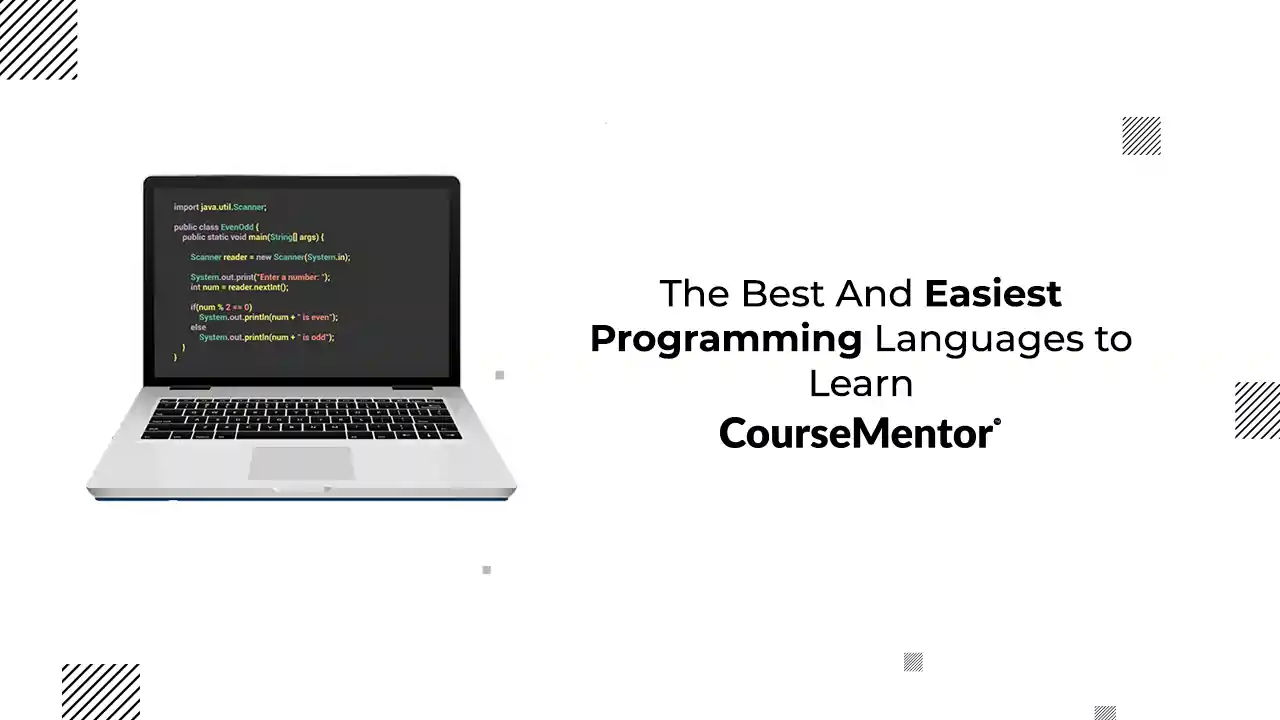Whether you want to uncover the secrets of the universe, or you just want to pursue a career in the 21st century, basic computer programming is an essential skill to learn. – Stephen Hawking
Most of the beginners ask us to answer, “what are the easiest programming languages to compete in 2021?” Well, the reason for this question might be that:
- Nowadays, there are more than 700 programming languages. Therefore, you have a variety of choices.
- To compete in this technological era, you want to get the easiest and quick way to enhance your skills.
- You want to learn multiple programming with ease and more.
Whatever the reason, I just want to help you know the best options for the easiest programming languages. So, without confusing you more, let’s jump to the details.
Do I really need to learn the programming language(s)?
Yes, you do.
There are various reasons to learn the programming language(s). Some of the most common reasons are listed below:
- Coding is Creativity, and it is also a more fun way to learn new things.
- You face Empowering & Life-Changing Experiences that support you in solving real-life problems too.
- When you work in a team, programming languages help you to Develop Interpersonal Skills.
- Programming supports getting an Attractive Salary plus Various Career Opportunities.
- Technologies Are Ruling the World; therefore, it helps you to compete with others.
- If you want to Develop Problem-Solving & Logical Skills, learning a programming language is the best way.
- A programming language allows you to Represent Computational Works in specific and effective ways.
How many programming languages are renowned in 2021?
I have already mentioned that there are 700+ programming languages. But from this number, some of them are successful in getting in the list of top 50.
Below, I have listed those 50 languages along with their ranking and ratings.
The top 20 programming languages are:
The other 30 top programming languages are:
I hope this will help you to know which is the best choice you have for learning. Select any of these programming languages if you already have a bit of knowledge of programming.
But if you are a beginner, then below, I have mentioned the easiest programming languages to start with.
Which is the easiest programming language to learn as a beginner?
Here are the top easiest programming languages. And, the best thing is that all these languages are most demanded in the industry and will surely continue in the future.
JavaScript
JavaScript is an open-source scripting or programming language. It is primarily developed for the client-side creation of web applications. However, it also supports server-side environment creation at present.
Moreover, someone can also use javascript to develop browser games and mobile apps by using various frameworks and libraries.
Javascript is an interpreted programming language. Therefore, anyone can perform the most complex task easily by breaking that task into pieces.
For these reasons, JavaScript is on 1st rank in the list of the easiest programming languages.
Some highlighting features of JavaScript are:
- Validating User’s Input.
- Handling Dates and Time.
- Detecting the User’s OS and browser.
- Greater Control.
- Simple Client-side Calculations.
- Platform Independent.
- Generating HTML Content.
Python
Python is the most powerful programming language that is very popular for its readability and super easy syntax. Therefore, it is very extremely useful and beginner-friendly.
Python is an object-oriented high-level programming language. It is useful in various domains such as machine learning, software development, web scripting, game development, etc.
The simplicity and flexibility of Python offer power and ease of use to beginners. Therefore, it isn’t incorrect to say that Python is one of the best and easiest programming languages.
Some highlighting features of Python are:
- Free and Open Source.
- GUI Programming Support.
- Extensible feature.
- An Integrated language.
- Easy to code.
- Object-Oriented Language.
- High-Level Language.
- A Portable language.
Java
James Gosling developed Java at Sun Microsystems in 1995. It was created for flexibility and to enable developers to write code that will execute on every computer.
Java is a general-purpose, object-oriented, and high-level programming language. Moreover, Java is the most preferred and flexible language.
There are more than 7 billion computers and mobiles that run Java. The reason for its popularity is its platform independence, active community support, and modular nature.
Moreover, Java plays a vital role in the market of the internet of things. For instance, IoT Medical devices, industrial robots, ATMs use the Java programming language on a large scale.
Some highlighting features of Java are:
- Platform Independent.
- Secure.
- Portable.
- Multithreaded.
- Object-Oriented.
- Simple.
- Architecture-neutral.
- Robust.
Ruby
Ruby is an open-source, dynamic, and general-purpose programming language. Its syntax is straightforward and easy to read and understand. Yukihiro Matsumoto developed the Ruby programming language, which is purely an object-oriented language.
Every element of Ruby is an object apart from blocks. However, there are replacements for it, such as procs and lambda. Ruby’s development was intended to act as a sensible buffer between human programmers and the underlying computing machinery.
Moreover, anyone can use Ruby for web development and to analyze data. Ruby is a great language to learn as a beginner and is one of the easiest programming languages.
Some highlighting features of Ruby are:
- Mixins.
- Flexibility.
- Object-oriented.
- Dynamic typing & Duck typing.
- Expressive feature.
- Garbage collector.
- Visual appearance.
- Exception handling.
C
C is a general-purpose language. Dennis Ritchie developed the C language at AT&T Bell Laboratories in the 1970s.
C is the language that most programmers learn at the very beginning of their programming career. Moreover, several traditional applications were developed with C. For example, Microsoft Windows kernel, Adobe Photoshop, MySQL are built using C.
C language is very easy to learn since it has only 32 keywords. Moreover, its data structures are quite easy to understand. C programming language’s place is quite high in the list of the easiest programming languages.
Some highlighting features of C are:
- Machine Independent or Portable.
- Structured programming language.
- Memory Management.
- Pointers.
- Simple.
- Mid-level programming language.
- Rich Library.
- Fast Speed.
PHP
PHP is a general-purpose, server-side scripting language for web applications. PHP scripts require the server to get interpreted. At the same time, the user computer requires only a web browser to run PHP web applications.
Earlier, PHP provided only the backend functionality of websites. However, today anyone can use PHP for command-line scripting, web apps, and desktop applications.
Several popular websites use PHP for the backend portion, i.e., Facebook, Yahoo, Wikipedia, etc. It is an easy-to-use language that beginners can easily understand.
Moreover, PHP is one of the oldest languages. However, it is still in huge demand.
Some highlighting features of PHP are:
- Interpreted.
- Open Source.
- Case Sensitive.
- Simple.
- Faster.
- Platform Independent.
- Error Reporting.
GO
It is an open-source and general-purpose programming language.
Go Developers can create web applications, web servers, and APIs with minimal frameworks. Its syntax and use-cases are pretty similar to C and C++. Moreover, it is straightforward to deploy a Go app running on Google Cloud.
Google developed this language to simplify various general and syntax
complexities, which makes it one of the easiest programming languages.
Some highlighting features of GO are:
- Language Design.
- Package Management.
- Concurrency Support.
- Binaries.
- Powerful standard library.
- Static Typing.
- Testing Support.
C#
C sharp or C# is a general-purpose, object-oriented programming language by Microsoft. C sharp developers generally build programs for Windows and web applications.
The syntax of C# is very similar to Java. Consequently, it is straightforward to learn for someone familiar with C/C++ or Java.
Moreover, C# is quite helpful for game developers. For example, the Unity game engine using C sharp allows game developers to develop games compatible with multiple platforms.
Some highlighting features of C# are:
- Simple.
- Object-oriented.
- Modern programming language.
- Interoperability.
- Component oriented.
- Typesafe.
- Scalable and Updateable.
- Structured programming language.
HTML
HTML is a markup language that developers use for web development.
Tim Berners Lee developed HTML in 1993. The markup tags are used to group and classify the elements of a web page. Afterward, the web browser reads these tags and translates them into a webpage that we see.
HTML is the basis of web development. It is one of the easiest programming languages to learn for someone interested in website development.
Some highlighting features of HTML are:
- Platform-independent.
- Hypertext can also add to the text.
- Easy to use and learn.
- Images, audio, and Videos can add to a web page.
- A markup language.
Get the comparison between PHP vs Python here.
What are the easiest programming languages for kids?
Nowadays, parents are looking forward to learning programming languages. The reason might be that programming languages are and will be the topmost demanded skills of job seekers. That is why parents should know what the best programming languages options to start with are.
Here are some of the easiest programming languages that kids can easily learn.
- Blockly
- Scratch
- Alice
- Turtle Art
- Tynker
Parents can use any of the below-mentioned options to take one step forward in their children’s learning journey. Check the available options and start learning today!
Bonus: Where can you start learning these programming languages?
There are tons of online resources where you can learn about these languages. Some of them are:
Blogs:
If you want to read programming language-related blogs, then you can bookmark these websites:
- CodeAvail
- CourseMentor
- Statanalytica
- CallTutors
- GeeksforGeeks
Video lectures:
- LiveLecture
- YouTube
- EdX
- Coursera
- Udemy
Apart from these, there are various offline resources also where you can find study materials. Some of the resources are:
- Book Shops
- Libraries
- Learning academies/institutes
- Your friends’ or someone else’s handwritten notes
Conclusion
Due to the demand and career scope in programming, everyone wants to learn it. But, everyone is confused about what are the easiest programming languages to get started with coding.
Therefore, this blog has provided information about the best and the easiest programming languages. Moreover, the online tutorials of all the above programming languages are easily available on the Internet. Anyone can choose a free or paid tutorial to start coding in these languages.
If you have any doubt, let me know about it. I will help you with your queries.
Frequently Asked Questions
Which language is best for beginners?
Python is one of the easiest programming languages. Beginners can start with this programming language as it has easy-to-understand syntax. Moreover, it is quite understandable to beginners.
How do I start coding for free?
There are numerous online platforms where you can start coding. Some of them are:
- Tutorialspoint
- geeksforgeeks
- Coursera
- Udemy
- Free code camp





